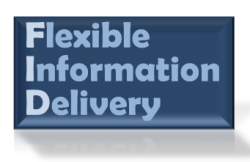Flexible Information Delivery – FID, for short (Part II)
 In my earlier post on Flexible Information Delivery (or FID), I described a few ways in which different types of users may want to view their business performance information. With an open, non-proprietary data base for information storage and management we can easily continue to expand our delivery methods.
In my earlier post on Flexible Information Delivery (or FID), I described a few ways in which different types of users may want to view their business performance information. With an open, non-proprietary data base for information storage and management we can easily continue to expand our delivery methods.
Let’s look at some of the information delivery methods that Silvon provides as examples that you may want to consider for FID in your enterprise.
- For basic to advanced analysis of information a web-based analytical tool that provides drill-down, roll-up and slice-and-dice capability is key. Simple and easy manipulation of time, of the way information is filtered and sorted, and selection and addition of information are things we have found to be important to the business user.
a - Scorecarding with the ability to drill into the detail of any specific cell representing a KPI. These active scorecards are good combinations of high-level information with simple access to the detail that was used to derive the information. Scorecards like this can be a one stop shop for KPI analysis.
a - Interactive Dashboards that provide consistent looks at information both in graphical form and via information grids. Dashboards can provide easy access (just go to a web page) and an easy-to-understand look at multiple views of information. Allowing users to work from simple web pages provides access to information regardless of the skill level of the user.
a - Mobile access to information. With the advent of BYOD (bring your own device) policies and more mobile device deployments, users are looking to work in a hybrid laptop/mobile device environment or in a mobile-device-only environment. Providing a consistent interface and terminology (through shared meta data) to information as users migrate to mobile devices is key to the success of mobile deployment of a business intelligence system today. Mobile users need to be able to use the unique features of the mobile device to view, analyze and share information.
a - Predominantly used by (but not limited to) financial users is Excel pivot table or power pivot access to automatically updated information. Through shared meta data and security, Excel users can easily see updated data using tools they are skilled and comfortable with while still sharing in the benefits of information collected and managed in a business intelligence system.
a - Scheduled reports that are delivered via email or to specific network or cloud locations. Providing users reports on a scheduled basis that they receive via email is a way to make sure everyone is getting at least the minimum information they need on a timely and regular basis.
a - Alerts allow users to focus on areas that require action. Often called exception management, alerts allow for business rules to be established and users to be notified of exceptions to those rules. Emails containing the specific information about business rule exceptions allow business users to quickly focus on areas for concern. With the ability to get back to the information that drove the alert and use the analytical tool to dig into the alert issue users can quickly determine what caused the alert and take action.
a - Complex and custom reporting and formatting often come up as real-world business requirements. Access to a report writing tool that allows for highly customized formatted reports is a nice addition to the FID methods available. Although not always a requirement it’s good to have a report writing tool that shares the information, meta data and security in the business intelligence solution.
a - Excel output. Users demand easy access to output formats that work well in Excel. Whether it is on demand or scheduled output, users will want to be able to get information to Excel quickly and easily.
a - Email and content sharing. Easily sharing the content included in a business intelligence system allows users to collaborate on issues and share information views and ideas.
Flexible Information Delivery allows users to share, analyze and view information in a variety of formats while not requiring additional collection and management of information on the back end. Not all of the FID options need to roll out as part the initial phase of a BI project. Knowing you have an infrastructure that supports FID and allows you to grow into FID methods that your users and organization requires will help assure you that you’re positioned to meet the information needs of your organization now and in the future.